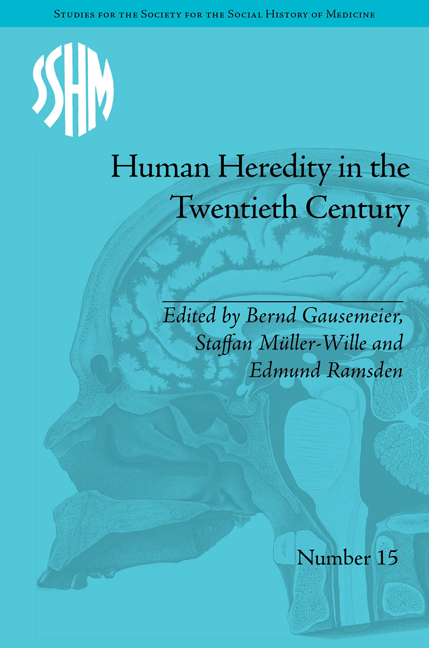Book contents
- Frontmatter
- Contents
- Acknowledgements
- List of Contributors
- List of Figures and Tables
- Introduction: Human Heredity in the Twentieth Century
- Part I Constructing Surveys of Heredity
- Part II Blood and Populations
- 4 From ‘Races’ to ‘Isolates’ and ‘Endogamous Communities’: Human Genetics and the Notion of Human Diversity in the 1950s
- 5 Between the Transfusion Services and Blood Group Research: Human Genetics in Britain during World War II
- 6 The Abandonment of Race: Researching Human Diversity in Switzerland, 1944–56
- 7 Post-War and Post-Revolution: Medical Genetics and Social Anthropology in Mexico, 1945–70
- Part III Human Heredity in the Laboratory
- Part IV Understanding and Managing Disease
- Part V Reconstructing Discipline(s)
- Notes
- Index
5 - Between the Transfusion Services and Blood Group Research: Human Genetics in Britain during World War II
from Part II - Blood and Populations
- Frontmatter
- Contents
- Acknowledgements
- List of Contributors
- List of Figures and Tables
- Introduction: Human Heredity in the Twentieth Century
- Part I Constructing Surveys of Heredity
- Part II Blood and Populations
- 4 From ‘Races’ to ‘Isolates’ and ‘Endogamous Communities’: Human Genetics and the Notion of Human Diversity in the 1950s
- 5 Between the Transfusion Services and Blood Group Research: Human Genetics in Britain during World War II
- 6 The Abandonment of Race: Researching Human Diversity in Switzerland, 1944–56
- 7 Post-War and Post-Revolution: Medical Genetics and Social Anthropology in Mexico, 1945–70
- Part III Human Heredity in the Laboratory
- Part IV Understanding and Managing Disease
- Part V Reconstructing Discipline(s)
- Notes
- Index
Summary
Shortly after the outbreak of World War II, geneticist R. A. Fisher and serologist George Taylor published an appeal to workers in the newly founded Emergency Blood Transfusion Service (EBTS). Taylor led the Galton Serum Unit, a Cambridge laboratory producing blood grouping reagents for a national network of hospitals and EBTS depots. Fisher was Taylor's former boss at University College London (UCL), who had recently relocated to the agricultural Rothamsted Experimental Station in Harpenden. The letter, entitled ‘Blood Groups of Great Britain’, entreated blood depot medical officers to send to Fisher or Taylor the records of transfusion volunteers. They explained that the records, which included the results of blood grouping tests, constituted valuable ‘genetical and ethnological data’ that could:
not only … throw light on points that require very large numbers for their elucidation, but will open up the field, at present wholly unexplored, of the homogeneity or heterogeneity in respect to blood groups of the population of these islands.
In response, the researchers were inundated with lists of donor records and blood grouping results. It represented the start of two wartime research programmes that Fisher and his colleagues conceived during these years. The first – to study the distribution of ABO blood group allele frequencies across Britain – made use of the many thousands of blood grouping records generated by the EBTS.
- Type
- Chapter
- Information
- Human Heredity in the Twentieth Century , pp. 69 - 84Publisher: Pickering & ChattoFirst published in: 2014



